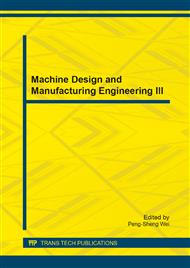p.17
p.21
p.25
p.29
p.33
p.37
p.43
p.47
p.51
Corrosion Behavior of Electrodeposited CoNiFe Nanoparticles Immersed in Different Environments
Abstract:
Replacement or repair of corrosion damaged equipment is the largest maintenance requirement for the industry. One technique for reducing the corrosion of metals is to coat them with thin layers of less reactive metals or alloys. Unfortunately, most metallic coatings are inherently porous and historically have been of little value as barriers against corrosion. Recently, with the development of new alternative material such as electrodeposited CoNiFe, these problems have largely been overcome. This paper investigated the effects of different aggressive environments on the corrosion behavior of electrodeposited CoNiFe. Interestingly, the mixed morphologies with spherical and dendritic structure were found in the neutral and alkaline environment. This morphology exhibited the smallest particle size with less percentage of oxygen elements. Besides, alkaline environment experienced the slowest corrosion rate due to the mixed morphology. It was found that spherical and dendritic refinement provides higher corrosion resistance. The corrosion rate of the sample prepared in alkaline environment was the lowest compared to the others due to the reduction of particle size.
Info:
Periodical:
Pages:
33-36
Citation:
Online since:
July 2014
Price:
Сopyright:
© 2014 Trans Tech Publications Ltd. All Rights Reserved
Share:
Citation:


